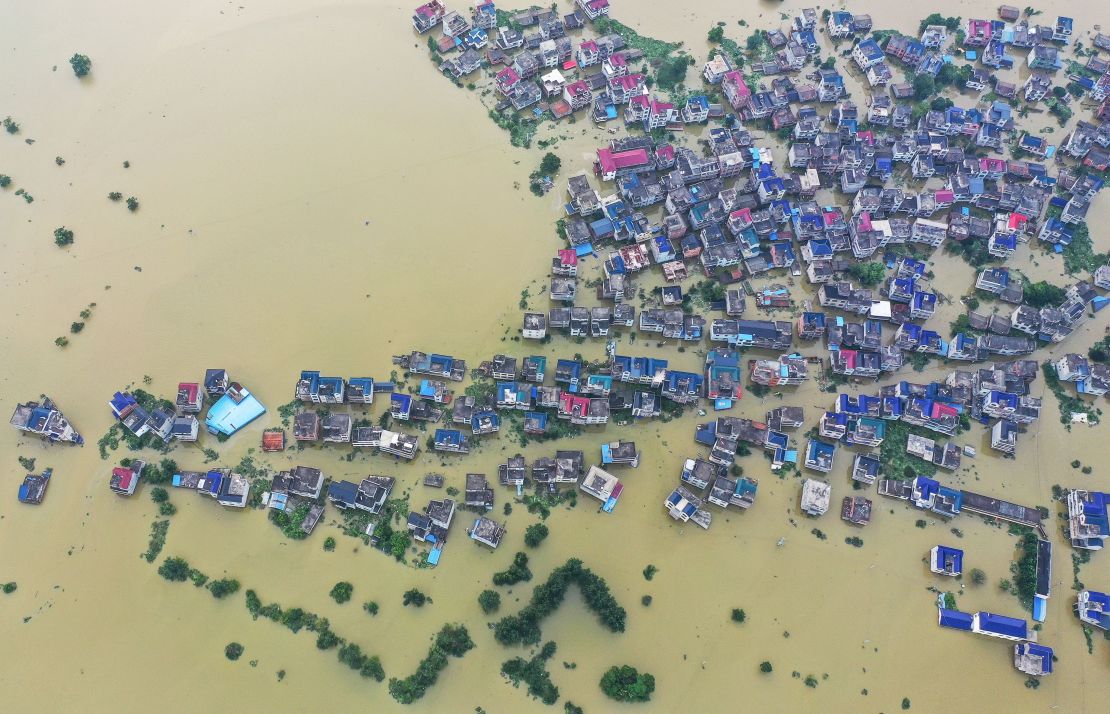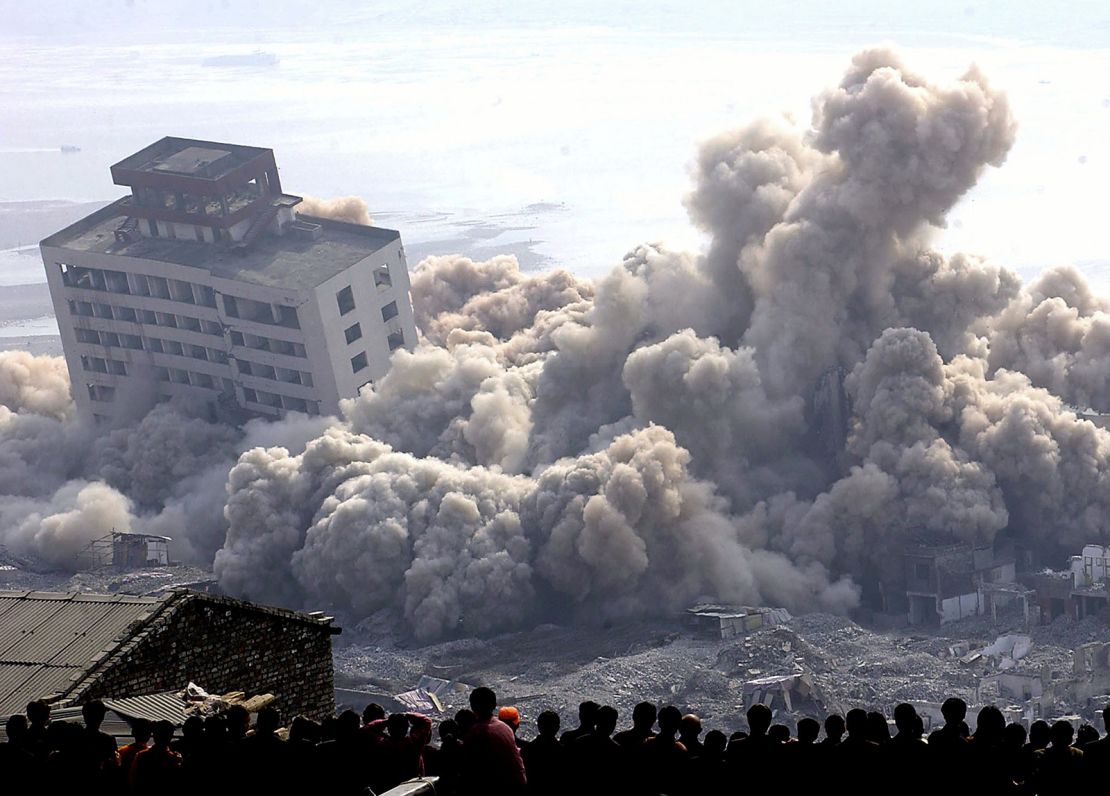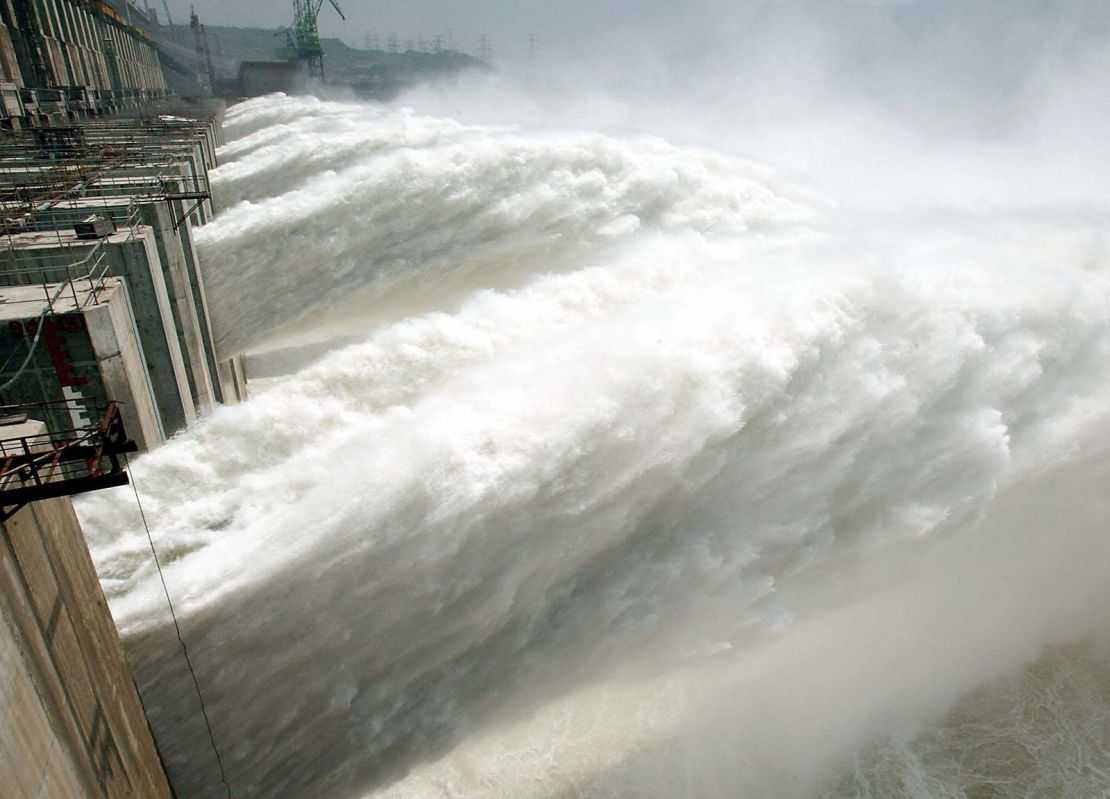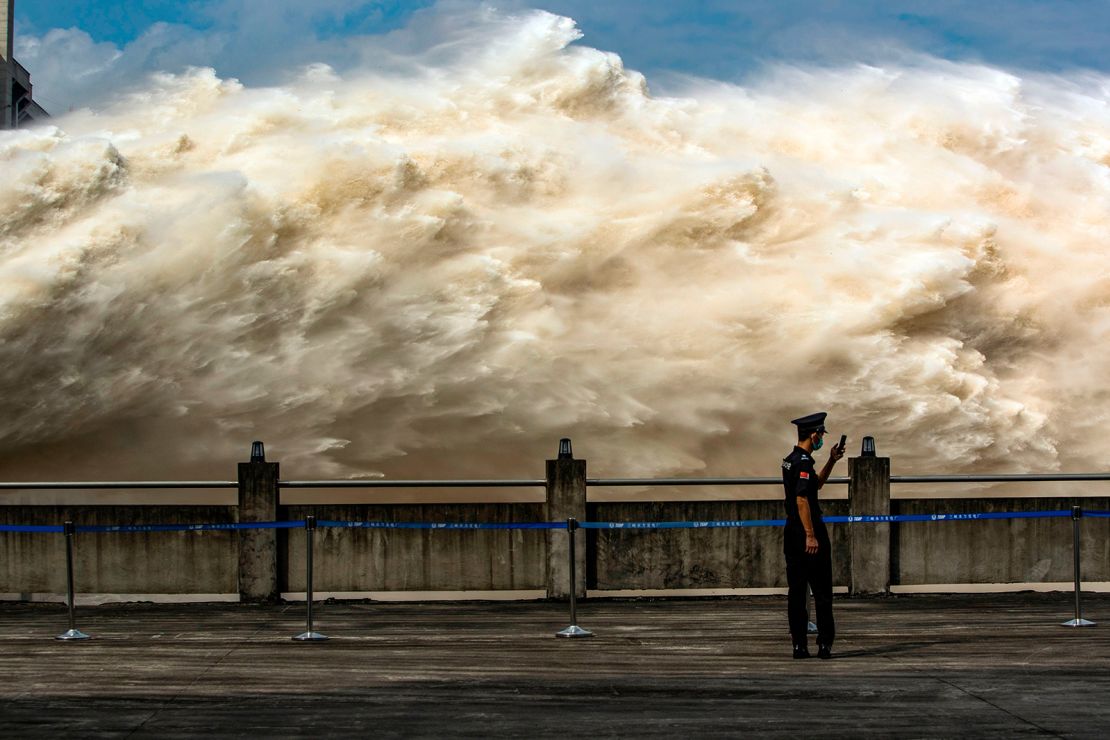Three Gorges Dam is the largest hydropower project ever built.
When construction began in 1994, it was designed not only to generate electricity to propel China’s breakneck economic growth, but also to tame China’s longest river, shield millions of people from fatal floods and, as a symbol of technological prowess, become a searing point of national pride.
But it hasn’t quite worked out that way.
For a start, the whole project cost 200 billion yuan ($28.6 billion), took nearly two decades to build, and required uprooting more than a million people along the Yangtze River. And while the government promised the dam would be able to protect communities around its immediate downstream against a “once in a century flood,” its efficacy has frequently been questioned.
Those doubts recently resurfaced, as the Yangtze basin saw its heaviest average rainfall in nearly 60 years since June, causing the river and its many tributaries to overflow.
More than 158 people have died or gone missing, 3.67 million residents have been displaced and 54.8 million people have been affected, causing a devastating 144 billion yuan ($20.5 billion) in economic losses.
Despite the havoc, Chinese authorities claim the Three Gorges Dam has succeeded in playing a “crucial role” in intercepting floodwaters. The dam’s operator, China Three Gorges Corporation, told China’s state news agency Xinhua that the dam has intercepted 18.2 billion cubic meters of potential floodwater. A water resources ministry official told state-run newspaper China Youth Daily that the dam “effectively reduced the speed and extent of water level rises” on the middle and lower reaches of the Yangtze.
But with multiple gauging stations monitoring river flows in the Yangtze basin seeing record-high water levels this summer, some geologists say the limited role of the Three Gorges Dam in flood control has been laid bare.
‘A tea cup for a big tub of water’
The Three Gorges Dam is an awe-inspiring structure.
Firstly, it is one of the few man-made structures on Earth that’s visible to the naked eye from space, according to NASA. Completed in 2006, the body of the dam is immense. It is 181 meters (607 feet) tall and spans 2,335 meters (1.45 miles) across the Yangtze just before the deep, narrow valley gives way to plains.
Then there’s its accompanying hydropower plant, which was completed in 2012 and has a generating capacity of 22,500 megawatts, or more than three times the capacity of the Grand Coulee Dam, the largest in the United States.
But according to the Chinese government’s 1992 proposal, the top reason for building the dam wasn’t power generation, but to prevent flooding.
In photos: China's Three Gorges Dam
Here’s how it works: the enormous dam is situated on an upstream section of the Yangtze and helps prevent flooding downstream by trapping rainwater in a huge reservoir, and then controlling the release of that water through its sluice gates. The 660 kilometer (410 mile) reservoir winds upstream through the narrow valleys of the Three Gorges – a series of steep canyons known for their imposing beauty and once treacherous currents – to Chongqing, a sprawling municipality of 30.5 million people in western China.
During the dry season, October to May, the reservoir’s water level is kept at a maximum of 175 meters (574 feet) to optimize electricity generation at the adjoining hydropower plant. Before the summer rains arrive in June, it’s gradually lowered to 145 meters (475 feet) to make room for the incoming floodwaters.
The lowering of water levels creates 22 billion cubic meters of storage space – enough to contain nearly 9 million Olympic-size swimming pools of water. But that’s nothing compared with the sheer volume of floodwater that can flow into the dam during bad years, said Fan Xiao, a Chinese geologist and long-time critic of the dam.
During a “once-a-century flood” more than 244 billion cubic meters of water – or about twice the volume of the Dead Sea – can pass through the Three Gorges in two months, according to Fan’s calculations.
The storage capacity of the dam’s reservoir can handle only about 9% of that amount, he added.
“It’s like using a small cup to deal with a big tub of water. In terms of flood control, the cost of the dam has surely outweighed the gain.”
Besides, the dam can only hold back the water for so long, as it has to make room for new rains – and in flood season torrential downpours can come in quick succession.
Last month, three flood waves have already hit the Three Gorges. The dam has opened its sluice gates multiple times since late June to release water from its reservoir, drawing criticism on Chinese social media that this exacerbated the floods downstream.
The company running the dam denied this, telling state-run tabloid the Global Times that it had helped to delay and stagger the floodwaters reaching downstream.
But Poyang Lake, in Jiangxi province, still swelled to its highest level in history – surpassing the previous record set by catastrophic floods in 1998, which killed more than 3,000 people. Other places downstream also broke historical records.

David Shankman, an emeritus professor of geography at the University of Alabama, who has studied flooding on the middle Yangtze, said the record-breaking water levels showed that the Three Gorges Dam could not prevent severe floods. “That’s a factual statement,” he said. “This dam is fully operational for many years now, and now we have the highest water level ever recorded.”
Studies by Chinese and foreign researchers over the years, Shankman added, have found that the dam’s reservoir is too small to significantly reduce downstream discharge during severe floods, although it does help alleviate flooding during normal years.
Miroslav Marence, an associate professor of storage and hydropower at the IHE Delft Institute for Water Education, said the problem is not the design of the dam, but the expectation that the dam can solve all the problems of flooding on the Yangtze, the third largest river by volume in the world. “It’s impossible to do it just with a dam,” he said.
For example, while the Three Gorges Dam can reduce the intensity of floods coming from upstream to a certain extent, it won’t be able to prevent floods caused by intense rainfall on the middle and lower reaches of the Yangtze or the tributaries in its basin entirely, he added.
And that is part of the problem: A lot of the flooding in central and southern China this summer, for instance, was caused by rains that fell downstream and didn’t ever go through the dam.
The dream of every Chinese leader
The Chinese have for millennia manipulated waterways for flood control, irrigation and navigation. For China’s imperial rulers, the ability to harness rivers not only saved lives and brought prosperity, but also gave legitimacy to their reign, as natural disasters were taken as a sign that the emperor had lost the mandate of heaven, by which he ruled.
This ambition to control water resources has only grown in modern times, with the prowess of technology.
Every Chinese leader since Sun Yat-sen, the founding father of modern China, dreamed of building a massive dam on the Yangtze, which has repeatedly wreaked havoc on its banks during flood season.
In an industrial blueprint he laid out for the Republic of China in 1919, Sun envisioned damming the Three Gorges to improve navigation and provide hydropower for the whole country.
The revolutionary leader did not live to see this dream realized. His successor Chiang Kai-shek carried on with the task in the 1940s, inviting renowned American engineer John L. Savage – best known for his work on the Hoover Dam – to survey the valleys and draw up a design for the Three Gorges Dam. Chiang even sent dozens of Chinese engineers to the US for training, but the project was abandoned during the Chinese Civil War.

After the Chinese Communist Party took power, Chairman Mao Zedong endorsed the project, writing about “walls of stone” and “a smooth lake rising in the narrow gorges” in a poem. But his plans were disrupted by the turmoil of the Great Leap Forward and the Cultural Revolution.
When his successor Deng Xiaoping brought up the idea again in the late 1970s, it was strongly opposed by some leading hydrologists, intellectuals and environmentalists, who pointed to its human and environmental costs, from the mass relocation of residents to threats of geological hazards, environmental damage and loss of archeological sites.
It was heavily debated throughout the next decade, which was the most politically relaxed and liberal era in the history of Chinese Communist rule. But following the Tiananmen Square massacre in 1989, open dissent was stifled and the political atmosphere turned oppressive. Four months after the massacre, authorities banned “Yangtze! Yangtze!” – a book highly critical of the project – and jailed its author, Dai Qing, a journalist and one of China’s earliest environmentalists.
Confident that it could now push through the plan, the government put the dam to a vote before the country’s legislature, the National People’s Congress (NPC), in 1992. The dam was approved, but about one-third of the delegates refused to endorse the plan – an astonishingly low approval rate for China’s usually compliant rubber-stamp parliament.

Some delegates said they were blindsided when the Three Gorges Dam suddenly appeared on the NPC’s agenda, without advance notice or discussions about the project, according to a 1994 edition of “Yangtze! Yangtze!”
Yang Xinren, a delegate from Jilin province in northeastern China, was quoted by the book as saying: “The majority of the delegates are not fully informed of the technical aspects of the project. So no matter how we vote, we vote in blindness.”
Why is the dam so controversial?
One of the most controversial aspects of the mega-project was its enormous cost for villagers who had lived for centuries on the banks of the river. To make way for the dam’s massive reservoir, about 1.4 million people were uprooted, their ancestral homes demolished, communities broken up and farmlands flooded.
Building the Three Gorges Dam displaced more people than the three largest Chinese dams before it combined. The reservoir submerged two cities, 114 towns and 1,680 villages along the river banks.

Displaced residents have complained about inadequate compensation and a lack of farmland and jobs after relocation. Many have accused local governments of embezzling resettlement funds and using excessive force to quell protests. In 2013, the Chinese government acknowledged that some of the funds were embezzled or misused.
Many also faced a reduction in living wages. According to Chen Guojie, a scholar at the government-backed Chinese Academy of Sciences, incomes of migrant families dropped by 20% after relocating, as they were forced to abandon their fertile riverside flatlands to farm on the steep, unsteady slopes.
The dam has also had a serious geological impact. Chinese officials and experts admitted at a forum in 2007 that the Three Gorges Dam had caused an array of ecological ills, including more frequent landslides, China’s state news agency Xinhua reported at the time.
“The huge weight of the water behind the Three Gorges Dam had started to erode the Yangtze’s banks in many places, which, together with frequent fluctuations in water levels, had triggered a series of landslides,” the Xinhua report said, citing officials and experts at a meeting.
The water in the reservoir saturates and erodes the base of the cliffs, and the fluctuation in water levels changes the weight of the reservoir and the pressure on the slopes, destabilizing the shoreline, geologists say.

The first disaster came in 2003, shortly after the reservoir started to fill for the first time. As the water reached 135 meters (115 feet), landslides began to occur. A few weeks later, on a tributary of the Three Gorges, a large chunk of a mountain split off and slipped into the river, killing 24 people, destroying 346 houses and capsizing over 20 boats.
The dam, which sits near two major fault lines, has also been blamed for a surge in earthquakes in the region. Scientists argue that the weight of the large reservoir and the permeation of water into the rocks underneath can trigger earthquakes in regions already under considerable tectonic stress.
According to a study from the China Earthquake Administration, in the six years after the reservoir was filled in June 2003, 3,429 earthquakes were recorded along the reservoir; only 94 earthquakes were recorded from January 2000 to May 2003.
Another major concern is the blocking of sediments. By cutting the flow of the Yangtze River, the dam has retained huge amounts of silt, which not only dampens its flood control capacity by filling the reservoir, but also causes significant erosion downstream.
And finally, the discovery of 80 large cracks on the Three Gorges Dam’s concrete face, just days after the reservoir was filled for the first time in 2003, didn’t help to alleviate concerns about the dam’s safety. Officials said at the time that the cracks were not a threat to the dam, but could cause leaking if not fixed, according to Xinhua.
For those who remembered the collapse of 62 dams in Henan in 1975, amid heavy downpours during a typhoon, it was of little comfort. That event killed more than 26,000 people by the official count – though other estimates were several times higher.
This year, as the floods worsened, rumors over the Three Gorges Dam’s deformation have resurfaced, drawing fierce rebuttal from state media.
But in 2011, the Chinese government admitted the Three Gorges Dam had created a range of major problems.
“While the Three Gorges project provides huge comprehensive benefits, there are urgent problems that need to be addressed, such as stabilizing and improving living conditions for relocated people, protecting the environment, and preventing geological disasters,” China’s cabinet, the State Council, said in a statement.
Changing attitudes
A month before the Three Gorges Dam broke ground in late 1994, Daniel P. Beard, the Commissioner of the US Bureau of Reclamation, declared “the dam building era in the United States” to be over, at an international conference. The US would be finding alternative ways to solve water problems.
The costs of such projects exceeded original estimates and many benefits were never realized, Beard said.

Shankman, the geologist at Alabama University, said many dams in the northwestern coast of the US were actually removed because they blocked the migration of fish from the ocean up the rivers, causing their populations to drop. In the southeast of the country, upstream dams in the mountains created environmental problems, driving fish species to extinction, causing water pollution, and the recession of coastlines due to the blocking of sediments.
Marence, the dam expert in the Netherlands, said after the boom in dam building from the 1950s to the 1980s, more countries and organizations started to become aware of their environmental impacts.
But China pushed on. By 2019, China had 23,841 large dams, accounting for 41% of the world total, with Fan saying most of them were built after 2000. The US was the runner-up on the list, with 9,263 large dams, according to the International Commission on Large Dams. The organization defines a “large dam” as a dam with a height of 15 meters (49 feet) or greater, or a dam between 5 meters and 15 meters which can contain more than 3 million cubic meters in its reservoir.
But dams with hydropower facilities do “produce a lot of cheap energy, and it’s renewable,” said Matthijs Kok, a hydraulic engineering professor at Delft University of Technology.
“However, they have an environmental price, and if we want to build new dams, we should look carefully at the environmental damage. We have to find compromise,” he said.
World's largest hydroelectric dams
Some geologists say instead of relying on dams to stop flooding, we should give rivers space and allow them to expand during the flood season.
“Large alluvial rivers naturally flood during the wet season. Floodwater is not a problem, that’s simply what rivers do. The problem is when you have a lot of people living in the areas that are subject to flooding,” Shankman said.
Along the middle and lower reaches of the Yangtze are some of China’s most densely populated areas. For centuries, people have built levees to protect their communities and farmlands from flooding. But these measures, too, are imperfect.
With the climate crisis expected to bring about heavier, more frequent flooding, some experts say China will be forced to find new solutions for future generations.
Graphics by CNN’s Jason Kwok.





































